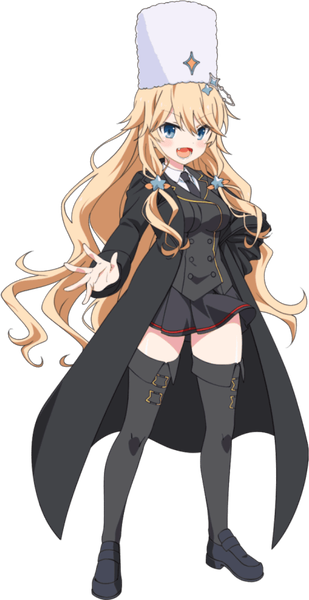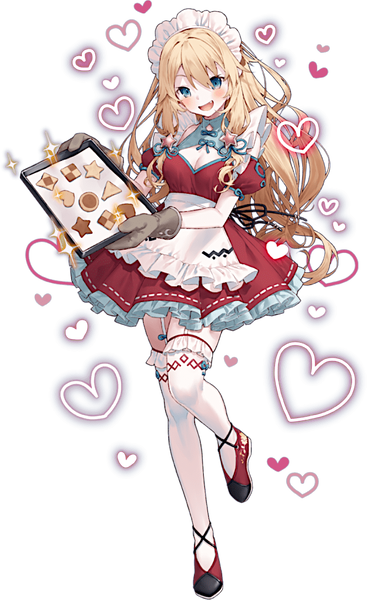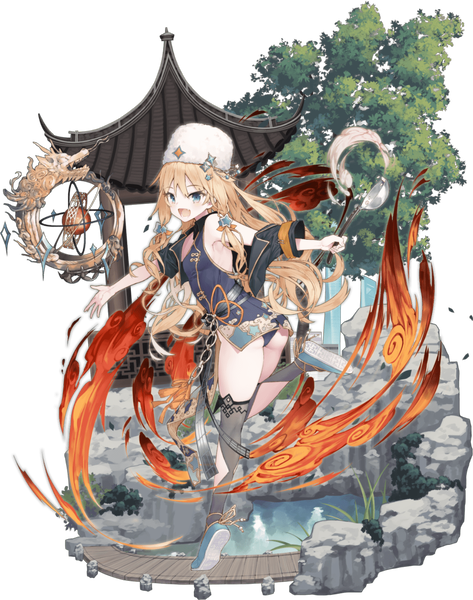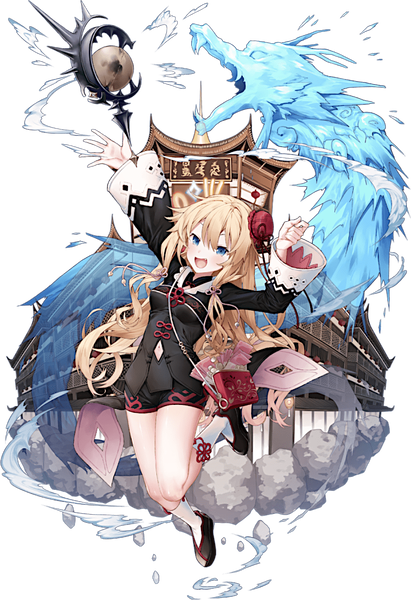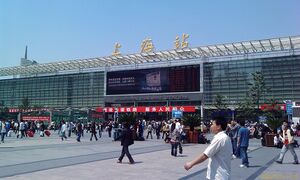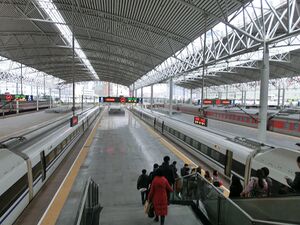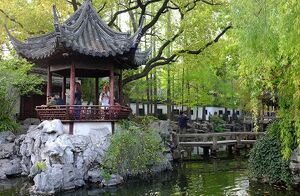Shanghai
| Shanghai | |||||
|---|---|---|---|---|---|
| Japanese Name | シャンハイ | ||||
| Weapon | |||||
| Race | Human | ||||
| Nationality | |||||
| Birthday | December 28 | ||||
| Constellation | Capricorn | ||||
| Talents | Mental arithmetic, Studying | ||||
| Likes | Beijing, Books written by Beijing, Freshwater crabs | ||||
| Dislikes | Delinquents, Hooligans, Punks | ||||
| Strengths | A broad perspective, Kind to the elderly and children | ||||
| Weaknesses | Cries when overwhelmed, Tries to fix everything with money | ||||
| Hobbies | Being an otaku | ||||
I'm Shanghai from Eisengrad. I'm from the same town as Beijing. We share the same taste in food too, so we are often going out to eat together. Probably good to point out that I'm pretty well off. Wh-what is that look for! You don't believe me!? If you keep treating me like a little kid, I won't be treating you to anything then!
Layers
| Icon | Title | Release Date | Where to Obtain |
|---|---|---|---|
| [Manhua-Loving Officer] Shanghai | 2023 February 8 | [Training Camp - Shanghai] Event Reward | |
| [Sometimes Lost] Shanghai | 2022 March 16 (EN) | [Goodbye Toy Box] Event Reward | |
| [Sharing What Everyone Loves] Shanghai | 2022 April 30 | [Lost Ship at the Wilderness End] Pick Up Gacha, Premium Gacha | |
| [Melancholy of the One-Day Maid] Shanghai | 2023 February 1 | [The Sickness Unto Chocolate] Event Reward | |
| [Naïve] Shanghai | 2022 March 16 (EN) | 0.5 Anniversary Limited Gacha 1 | |
| [Shanghai☆Delivery] Shanghai | 2023 February 14 | [Skyscraper's Guernica] Pick Up Gacha, Premium Gacha |
Skills
Trivia
- Shanghai's birthday is the opening date of Shanghai railway station in 1987.
- Shanghai is Beijing's close friend and primary investor for her research.
- Shanghai's liking for freshwater crabs references the Chinese mitten crab (大闸蟹/大閘蟹; pinyin: dàzháxiè), also known as the Shanghai hairy crab (上海毛蟹, pinyin: Shànghǎi máoxiè). It is a medium-sized freshwater burrowing crab that is named for its furry claws, which resemble mittens. The Shanghai hairy crab is an important part of Shanghai cuisine.
- The real life Shanghai Station's appearance can be seen as the waist belt in the outfits of [Sometimes Lost] and [Naïve].
- Shanghai's weapon is a celestial globe (浑天仪).
- Shanghai's dislike for delinquents, hooligans and punks is a reference to the mafia history of Shanghai, namely the Green Gang (Qing Bang, 青帮). Shanghai is also famous thanks to The Bund (or Shanghai Beach, 上海滩), a Hong Kong period drama television series first broadcast on TVB in 1980. It is praised as "The Godfather of the East" and spawned two sequels, two remakes, and a film adaptation. The theme song, which shares the same Chinese title as the series and was performed by Frances Yip, also became a memorable Cantopop hit.
- The building in the background of [Naïve] is the Yu Garden, built in 1559 during the Ming Dynasty by Pan Yunduan as a comfort for his father, the minister Pan En.
Counterpart
Shanghai railway station (上海火车站/上海火車站 pinyin: Shànghǎi Huǒchēzhàn) is one of the four major railway stations in Shanghai, China, the others being Shanghai South (Shanghainan), Shanghai Hongqiao, and Shanghai West (Shanghaixi). The station is located on Moling Road, Jing'an District, to the North of the city centre. It is governed by Shanghai Railway Bureau and is one of the most important hubs of the railway network in China.
Shanghai station is called "the new railway station" - 新客站 since it replaced Shanghai North railway station (also known as "Old North railway station", or "Old North Station" - 老北站 by locals) as the city's main train station in 1987. In the late '80s, the old North railway station was inadequate to handle the increasing railway traffic in Shanghai. The government then decided to pull down the Shanghai East (freight) railway station and build a new railway station at the same place. On 28 December 1987, the North railway station was closed and the new Shanghai railway station was opened at the same time.
The design of Shanghai Railway Station's station hall adopts the "南北开口、高进低出、跨线候车" scheme for efficiency reasons, meaning "openings from north and south, entry from high and exit from low, cross-line waiting", proposed by East China Architectural Design Institute. The station is accessible through the north and south entrances. Special VIP waiting entrances are also available to the east of the entrance, which leads directly to the VIP waiting room. Passengers who board the bus transportation can exit the station quickly through the underground passage through the southeast, southwest and north exits. 80% of the waiting room is located in the elevated waiting room above the platform.
Shanghai station primarily serves north–south and westward locations. It is the terminus of the main Beijing-Shanghai railway line. In 2006, some railway lines of the station were moved to the reopened Shanghai South railway station, which lessened the increasing pressure of passenger traffic. In August 2006, a decision was made to renovate the aging station and its surrounding area. Many new ticket machines were installed to increase efficiency. Wikipedia
Yu Garden or Yuyuan Garden (豫园/豫園; pinyin: Yù Yuán) is an extensive Chinese garden located beside the City God Temple in the northeast of the Old City of Shanghai at Huangpu District, Shanghai. It abuts the Yuyuan Tourist Mart, the Huxinting Teahouse and the Yu Garden Bazaar. The garden is accessible from the Shanghai Metro's Line 10 and Line 14 Yuyuan Garden station. The centerpiece is the Exquisite Jade Rock (玉玲珑) a porous 3.3m, 5-ton boulder. Rumours about its origin include the story that it was meant for the Huizong Emperor (Northern Song Dynasty from 1100 to 1126 AD) at the imperial palace in Beijing, but was salvaged from the Huangpu River after the boat carrying it had sunk.
The gardens suffered damage numerous times during the 19th century. During the First Opium War, the British army used the Huxinting Teahouse as a base of operations for several days in 1842. During the Taiping Rebellion, the Small Swords Society ran its headquarters in the Dianchun Hall; by the time Qing troops recovered the garden, the original structures had nearly all been destroyed. They were damaged again by the Japanese in 1942 before being repaired by Liangshun Han (Rockery Han) appointed by the Shanghai government from 1956 to 1961. They were opened to the public in 1961 and declared a national monument in 1982.
Today, Yu Garden occupies an area of 2 hectares (5 acres), and is divided into six general areas laid out in the Suzhou style - Sansui Hall (三穗堂, Sān Suì Táng), Wanhua Chamber (万花楼, Wàn Huā Lóu), Dianchun Hall (点春堂, Diǎn Chūn Táng), Huijing Hall (会景楼, Huì Jǐng Lóu), Yuhua Hall (玉华堂, Yù Huá Táng), and Inner Garden (内园, Nèi Yuán). Each area is separated from the others by "dragon walls" with undulating gray tiled ridges, each terminating in a dragon's head. Wikipedia
Map
Gallery
- Pages using Tabber parser tag
- Pages using DynamicPageList3 parser tag
- Weapon Artifact
- Human
- Eisengrad
- Capricorn
- Element Cut
- Element Light
- Element Fire
- Element Water
- Element Wind
- Train Knights
- China

